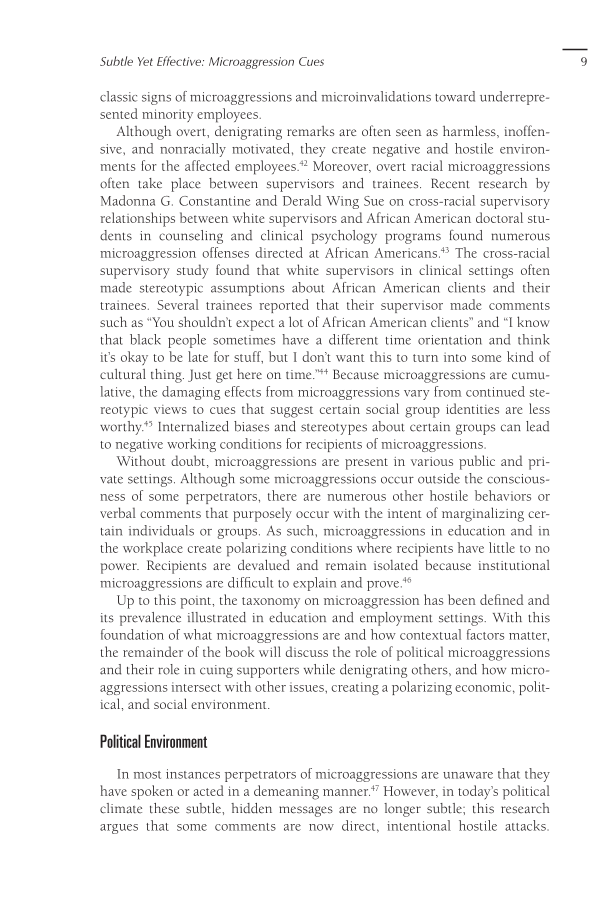Subtle Yet Effective: Microaggression Cues 9 classic signs of microaggressions and microinvalidations toward underrepre- sented minority employees. Although overt, denigrating remarks are often seen as harmless, inoffen- sive, and nonracially motivated, they create negative and hostile environ- ments for the affected employees.42 Moreover, overt racial microaggressions often take place between supervisors and trainees. Recent research by Madonna G. Constantine and Derald Wing Sue on cross-racial supervisory relationships between white supervisors and African American doctoral stu- dents in counseling and clinical psychology programs found numerous microaggression offenses directed at African Americans.43 The cross-racial supervisory study found that white supervisors in clinical settings often made stereotypic assumptions about African American clients and their trainees. Several trainees reported that their supervisor made comments such as “You shouldn’t expect a lot of African American clients” and “I know that black people sometimes have a different time orientation and think it’s okay to be late for stuff, but I don’t want this to turn into some kind of cultural thing. Just get here on time.”44 Because microaggressions are cumu- lative, the damaging effects from microaggressions vary from continued ste- reotypic views to cues that suggest certain social group identities are less worthy.45 Internalized biases and stereotypes about certain groups can lead to negative working conditions for recipients of microaggressions. Without doubt, microaggressions are present in various public and pri- vate settings. Although some microaggressions occur outside the conscious- ness of some perpetrators, there are numerous other hostile behaviors or verbal comments that purposely occur with the intent of marginalizing cer- tain individuals or groups. As such, microaggressions in education and in the workplace create polarizing conditions where recipients have little to no power. Recipients are devalued and remain isolated because institutional microaggressions are difficult to explain and prove.46 Up to this point, the taxonomy on microaggression has been defined and its prevalence illustrated in education and employment settings. With this foundation of what microaggressions are and how contextual factors matter, the remainder of the book will discuss the role of political microaggressions and their role in cuing supporters while denigrating others, and how micro- aggressions intersect with other issues, creating a polarizing economic, polit- ical, and social environment. Political Environment In most instances perpetrators of microaggressions are unaware that they have spoken or acted in a demeaning manner.47 However, in today’s political climate these subtle, hidden messages are no longer subtle this research argues that some comments are now direct, intentional hostile attacks.
Document Details My Account Print multiple pages
Print
You have printed 0 times in the last 24 hours.
Your print count will reset on at .
You may print 0 more time(s) before then.
You may print a maximum of 0 pages at a time.










































































































































































